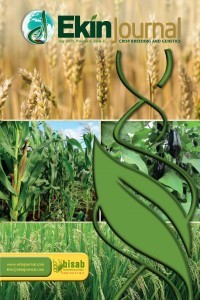Varietal Screening in Chickpea Against Gram Pod Borer, Helicoverpa armigera (Hub.) in Field Conditions Using Biochemical Parameters
Varietal Screening in Chickpea Against Gram Pod Borer, Helicoverpa armigera (Hub.) in Field Conditions Using Biochemical Parameters
biochemical, chickpea Helicoverpa, pod borer, screening,
___
- Bhatt NJ and Patel RK, (2001) Screening of chickpea cultivars for their resistance to gram pod borer, Helicoverpa armigera. lndian Journal of Entomology, 63(3), 277-280.
- Bhagwat VR, Aherker SK, Satpute VS and Thakre HS, (1995) Screening of chieckpea (Cicer arientinum L.) genotypes for resistance to Helicoverpa armigera (Hb.) and its relationship with malic acid in leaf exudates. Journal of Entomological Research, 19, 249-253.
- Chhabra KS, Sharma AK, Saxena AK and Kooner BS, (1990) Sources of resistance in chickpea; role of biochemical components of the incidence of gram pod borer, Helicoverpa armigera (Hubner). Indian Journal of Entomology, 52, 423-430.
- Girija Salimath, PM, Patil SA, Gowda CLL and Sharma HC, (2008) Biophysical and biochemical basis of plant resistance to pod borer [Helicoverpa armigera (Hubner)] in chickpea (Cicer arietinum L.). Indian Journal of Genetics, 68(3), 320-323.
- Hossain MA, (2009) Field screening of chickpea genotypes against pod borer. Bangladesh Journal of Agricultural Research, 34(3), 517-521.
- Jukanti AK, Gaur PM, Gowdal CLL and Chibbar RN, (2012) Nutritional quality and health benefits of chickpea (Cicer arietinum L.): A review. British Journal of Nutrient, 108(1), 11-26.
- Lateef SS, (1985) Gram pod borer [Heliothis armigera (Hub.)] resistance to chickpea. Agriculture, Ecosystem & Environment, 14, 95-102.
- Lateef SS and Reed W, (1995) A suggested system of rating pigeonpea and chickpea entries for field resistant to Heliothis armigera. In: Proceedings of the National seminar on breeding crop plants for resistance to pests and diseases, pp. 25-27. Tamil Nadu Agricultural University, Coimbatore, Tamil Nadu, India.
- Nadeem S, Hamed M, Shafique M, Atta BM and Shah TM, (2011) Evaluation for resistance in kabuli chickpea genotypes against chickpea pod borer, Helicoverpa armigera (Hubner) (Lepidoptera: Noctuidae) under field conditions. Songklanakarin Journal of Science and Technology, 33(3), 291-294.
- Patnaik HP and Senapati B, (1995) Influence of acidity of chickpea leaves on the incidence of Heliothis armigera (Hubner) in resistance/susceptibility cultivar. Journal of Entomological Research, 31, 105-108.
- Pawar VM, (1998) Microbial control of Helicoverpa sp. on pulse crops. IPM systems in Agriculture, pp:55-78. Aditya books private limtited, New Delhi, India.
- Rembold H, (1981). Malic acid in chickpea exudates a marker for Heliothis resistance. International Chickpea Newsletter, 4, 18-19.
- Rembold H, Wallner P, Kohne A, Lateef SS, Grune M and Weigner CH, (1990) Mechanisms of host plant resistance with special emphasis on biochemical factors. Proceedings of the Second International Workshop on Chickpea Improvement, p.191. ICRISAT/ICARDA, Patancheru, Andhra Pradesh, India.
- Sharma HC, Gowda CLL, Sharma KK, Gaur PM, Mallikkarjuna N, Buhariwalla HK and Crouch JH, (2003) Host plant resistance to pod borer. Helicoverpa armigera in chickpea. Chickpea Research for the Millenium; Proceedings, International Chikpea Conference, pp. 118-137.
- Shankar M, Munghate RS, Babu TR, Sridevi D and Sharma HC (2014) Population density and damage by pod borers, Helicoverpa armigera and Spodoptera exigua in a diverse array of chickpea genotypes under natural infestation in the field. Indian Journal of Entomology, 76(2), 117-127.
- Singh B and Yadav RP (1999) Field screening of chickpea (Cicer arietinum L.) genotypes against gram pod borer (Helicoverpa armigera Hub.) under late sown conditions. Journal of Entomological Research, 23(2), 133-140.
- Sithanantham S, (1987). lnsect pests of pigeonpea and chickpea and their management. Plant protection in field crops, p. 159. Plant Protection Association of India. Hyderabad, Andhra Pradesh, India.
- Vaishampayam SM and Veda OP, (1980) Population dynamics of gram pod borer, Helicoverpa armigera (Hubner) and its outbreak situation on gram, Cicer arietinum L. at Jabalpur. Indian Journal of Entomology, 42, 453-459.
- Yoshida M, Cowgill SE and Wightman JA, (1995) Mechanism of resistance to Helicoverpa armigera (Lepidoptera: Noctuidae) in chickpea: Role of oxalic acid in leaf exudates as antibiotic factor. Journal of Economic Entomology, 88, 1783-1786.
- ISSN: 2149-1275
- Yayın Aralığı: Yılda 2 Sayı
- Başlangıç: 2015
- Yayıncı: Bitki Islahçıları Alt Birliği
Pritish JAKHAR, Yogesh KUMAR, Arun JANU
Jagdeep SINGH1, Ashok Kumar CHHABRA
Amel BENSELAMA, Faiza OUAREM, Sihem TELLAH, S. Mohamed OUNANE, Ghania OUNANE
Combining Ability Analysis and Heterotic Effects for Cotton Fiber Quality Traits
Poaceae Weed Hosts of Yellow dwarf viruses (YDVs) in the Trakya Region of Turkey
Havva ILBAGI, Ahmet CITIR, Adnan KARA, Meryem UYSAL
Suresh SURESH, Om Parkash BISHNOI, Rishi Kumar BEHL
Public Popcorn Breeding Studies of Turkey
Sekip ERDAL, Ahmet OZTURK, Mehmet PAMUKCU, Erkan OZATA, Mehmet Cavit SEZER
